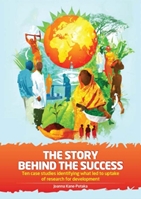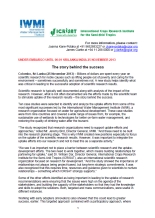Research only solves problems if it is put into practice.
With that in mind, researchers from IWMI and several other large organizations spent three years working together to find ways of boosting water access for smallholders in Africa and Asia, and ensuring their findings resulted in action on the ground.
Through the AgWater Solutions Project (AWM) – led by IWMI – they engaged farmers, NGOs, government agencies and donors, responding to their priorities, roles and needs http://awm-solutions.iwmi.org/
This “uptake” work paid off. By the project’s conclusion, a number of promising outcomes had been generated, including commitments by Tanzania’s government to put money into such recommended solutions as canal rehabilitation, farmer microcredit financing and additional agricultural extension officers.
Another, from Thailand, focused on efforts to switch some farmers in the north of the country away from rice production due to the risk to human health of consuming rice grown in water containing high levels of naturally-occurring cadmium. The research resulted in recommendations from the Thai government for farmers to switch to non-food crops – in this case sugarcane for biofuel – as well as the removal of contaminated rice from the food chain and the compensation of communities affected by kidney disease linked to the contaminated rice.
Both case studies are featured in “The Story behind the success”, a new book that examines some of IWMI’s work over the past decade, and what efforts led to achieving uptake or impact.
“The case studies show that uptake is a discipline in its own right that needs to be integrated into the research from the beginning to ensure project recommendations are adopted,” says Joanna Kane-Potaka, who wrote the book while she was Director of IWMI’s Information and Knowledge Group. She is now Director of Strategic Marketing and Communication for the International Crops Research Institute for the Semi-Arid Tropics (ICRISAT) based in Hyderabad, India.
Her study was based mainly on interviews with research scientists, who typically were in close communication with the adopters of the project recommendations. The cases spanned nine countries and a variety of development issues ranging from the sustainable use of wetlands to restoring the quality of drinking water after the 2004 Asian tsunami.
Kane-Potaka found that while a variety of uptake approaches were effective, a common thread is relationship building with key policy makers, donors, nonprofits, and farmer groups.
“This included consciously identifying which stakeholders to involve, when to engage, how to engage, and the appropriate level of engagement,” she says. “Stakeholders who take ownership of the research results and solutions in effect become ambassadors and continue uptake efforts even after the life of the project.”
Sometimes uptake occurs naturally. For example, IWMI researchers investigated whether water in the rice irrigation system in northern Thailand was leading to abnormally high levels of kidney disease and failure among the elderly. Through surveys, sampling, laboratory testing and mapping, IWMI scientists were able to show that irrigation water had picked up cadmium from the soil and deposited the toxic heavy metal into the irrigated fields. IWMI recommended that farmers be assisted in converting their farms into other products such as sugarcane for ethanol.
Although IWMI didn’t devise a formal uptake strategy, it did have a close relationship with key policymakers. The Thai government ultimately took IWMI’s advice and helped 2,000 farming households switch to alternative crops such as sugarcane – an ethanol plant was built from loans from a mining company and the government.
“No specific uptake strategy was documented,” Kane-Potaka says. “However, a conscious effort was made to influence the government to adopt IWMI’s recommendations and those efforts paid off.”
While uptake can occur without a formal mechanism in place, Kane-Potaka says research shows that it’s most effective when uptake is a formal, “iterative and incremental” strategy and supported by the research organization. In addition to building relationships with key players, other critical ingredients include increasing the capacity of stakeholders if necessary, using monitoring and evaluation to feed back into the ongoing uptake planning, and providing targeted communications.
Those elements were part of the AWM project, which was funded by the Gates Foundation and included as partners the U.N. Food and Agriculture Organization, the International Food Policy Research Institute, the Stockholm Environment Institute, and iDE, a U.S.-based nonprofit.
While many studies already had concluded the need for investments in smallholder agricultural water management, the AWM project recommended where and how donors, implementing agencies and policymakers should invest in order to achieve the greatest benefits to farmer livelihoods.
Uptake was part of all stages of the project. Formal surveys were conducted early on to identify the most relevant stakeholders. Personal and professional networking also was key to reaching those who would use or benefit from the research. Final recommendations were promoted through a global campaign that targeted international donors.
“Researchers were initially hesitant to engage with stakeholders at early stages of the research phase, because of the concern in sharing prelimi
nary research results which still might change,” Kane-Potaka says. “However, by the end of the project it was recognized that sharing information only had positive benefits — when approached appropriately and carefully.”



